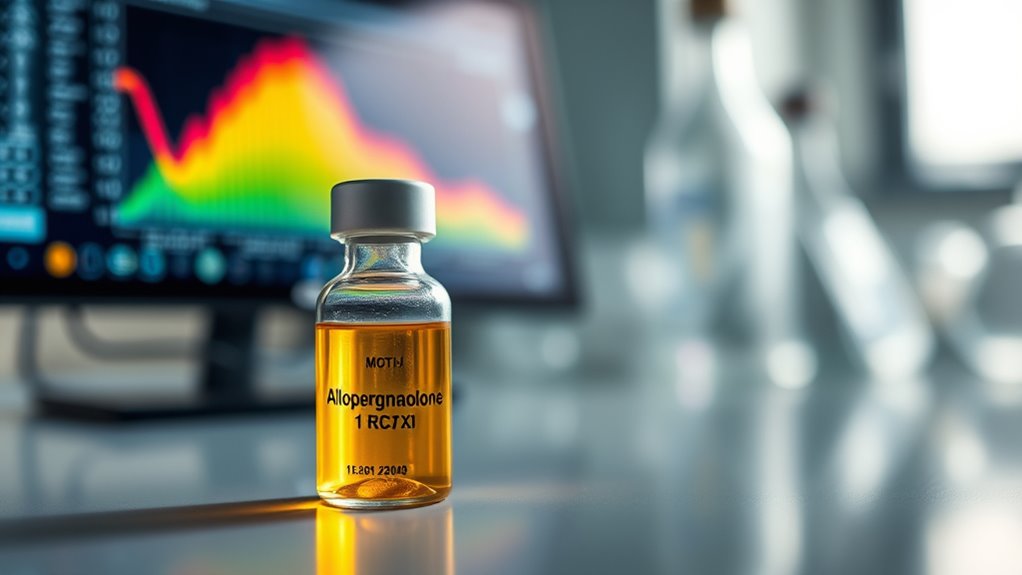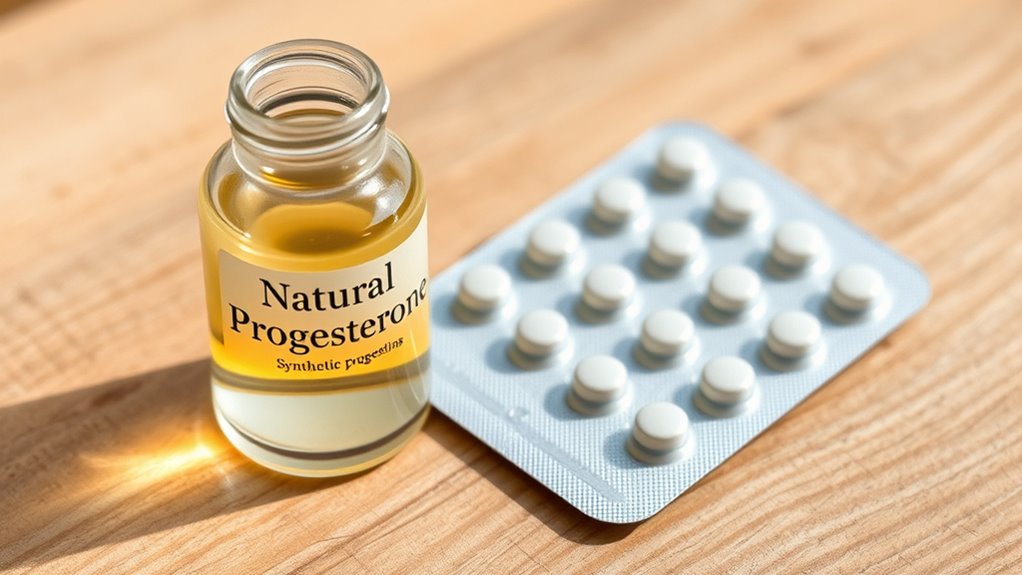Progesterone influences your mood by converting into neurosteroids like allopregnanolone, which modulate GABA-A receptors to promote calmness and emotional stability. Fluctuations during your menstrual cycle or postpartum can trigger feelings of irritability, anxiety, or depression, especially if receptor sensitivity is altered. Understanding these hormonal shifts helps explain mood swings and offers potential treatments. If you want to learn how hormone levels and receptor responses impact your mood, keep exploring this connection.
Key Takeaways
- Rising progesterone during the luteal phase promotes emotional stability, while its decline premenstrually links to irritability and mood swings.
- Progesterone converts into neurosteroids like allopregnanolone, which modulate GABA-A receptors to promote calmness and emotional regulation.
- Fluctuations in neurosteroid levels, especially allopregnanolone, influence mood, with low levels associated with depression and anxiety.
- Synthetic progestins don’t produce neurosteroids like allopregnanolone, often leading to unpredictable or negative mood effects.
- Postpartum hormonal shifts, including decreased progesterone, can increase mood instability and risk of depression, which targeted treatments may help address.
How Fluctuations in Progesterone Affect Mood

Have you ever wondered how changes in progesterone levels influence your mood? When your progesterone rises during the luteal phase, you might feel more stable, but as levels sharply decline before your period, negative emotions can surface. This drop is linked to increased stress and mood swings, making you feel irritable, anxious, or even sad. Women with heightened sensitivity to hormonal shifts—especially those with pre-existing mood or psychiatric conditions—are more vulnerable to these fluctuations. Cyclical changes in progesterone can trigger symptoms like depression or irritability, primarily during premenstrual times. These mood shifts aren’t just psychological; they involve complex neurochemical mechanisms, including the brain’s GABA system, which helps regulate your emotional responses. Understanding these fluctuations helps explain why your mood can vary so much during your cycle. Additionally, hormonal fluctuations can influence neurochemical pathways, amplifying emotional responses, especially in individuals with hormone-sensitive mood disorders. Recent research also suggests that fluctuations in progesterone may impact neurochemical pathways, further affecting mood stability.
The Role of Allopregnanolone and Neurosteroids

Allopregnanolone, a neurosteroid derived from progesterone, influences mood by modulating GABA-A receptors, enhancing inhibitory signaling in the brain. You’ll find that its effects depend on receptor sensitivity, with some individuals showing heightened responses that can affect mood stability. Understanding this interaction helps explain how neurosteroids like allopregnanolone impact emotional regulation and stress resilience. Additionally, fluctuations in neurosteroid levels can contribute to mood disorders, highlighting their importance in mental health. The biosynthesis of neurosteroids from progesterone is a complex process that affects their levels and activity within the nervous system. Ongoing research into AI safety measures underscores the importance of robust safety protocols, which can be paralleled to the need for careful regulation of neurosteroid production to ensure mood stability.
Neurosteroid Modulation of GABA
Neurosteroids like allopregnanolone play a crucial role in regulating mood by modulating GABA-A receptor activity in the brain. They enhance receptor function by binding to specific sites, influenced by receptor subunit composition, which leads to different behavioral effects. These neurosteroids act rapidly through non-genomic mechanisms, affecting neural excitability and mood. Their modulation can either potentiate or inhibit GABA-A receptor activity, depending on their structure. The effects vary across brain regions, impacting anxiety, cognition, and emotional regulation. Understanding these interactions helps explain how fluctuations in neurosteroid levels influence mood states and offers potential targets for mood disorder treatments.
- Neurosteroids bind to specific GABA-A receptor sites
- They influence receptor activity based on subunit makeup
- Allopregnanolone has anxiolytic properties
- Rapid, non-genomic effects affect mood quickly
- Modulation varies across brain regions
Allopregnanolone’s Mood Effects
How exactly does allopregnanolone influence mood? It interacts with GABA-A receptors, enhancing their inhibitory effects and stabilizing neurotransmitter activity. This neurosteroid has shown promise in treating depression and anxiety, thanks to its neuroprotective properties. Reduced levels of allopregnanolone are linked to mood disorders like depression and PTSD, possibly due to enzymatic deficits that impair its synthesis. During the peripartum period, fluctuations in allopregnanolone can affect mood, with some women being more sensitive to these hormonal changes—following a U-shaped relationship. Clinical studies highlight its rapid antidepressant effects, especially with medications like brexanolone for postpartum depression. Overall, allopregnanolone’s mood effects depend on its levels, receptor interactions, and individual hormonal responses. Additionally, disruptions in neurosteroid synthesis may contribute to hormonal imbalances associated with mood disturbances. Emerging research on neurosteroid pathways is providing new insights into targeted therapies for mood disorders. Moreover, understanding how neurosteroid production is regulated could lead to more effective treatments for mood-related conditions.
Sensitivity in Receptor Adaptation
Receptor sensitivity plays a pivotal role in how neurosteroids like allopregnanolone influence mood. When levels of neurosteroids fluctuate, receptor adaptation occurs, impacting neural excitability and emotional responses. This sensitivity determines how well your brain responds to mood-regulating signals, especially during hormonal changes. If receptor sensitivity becomes dysregulated, it can lead to mood instability or disorders like PMDD. The brain’s ability to adjust receptor activity influences emotional resilience and stress management. Understanding this process helps explain why some individuals are more vulnerable to mood shifts during hormonal transitions. Receptor sensitivity is also influenced by environmental factors and lifestyle choices, which can further modulate your emotional responses. Ultimately, receptor adaptation acts as a dynamic interface between neurosteroid levels and your emotional well-being. Additionally, research suggests that candles can play a calming role in managing stress, indirectly supporting receptor stability during hormonal fluctuations.
Differences Between Natural Progesterone and Synthetic Progestins

You should know that natural progesterone converts into neurosteroids like allopregnanolone, which can help calm your mood. Synthetic progestins, however, don’t produce these calming neurosteroids, so their effects on mood can be unpredictable. Understanding these differences is key to grasping how each hormone influences your mental well-being. Additionally, the market growth in AI technology highlights ongoing innovations that could one day influence health monitoring and treatment options.
Conversion to Neurosteroids
Did you know that natural progesterone can be converted into neuroactive steroids within the brain, influencing mood and emotional regulation? When synthesized in the nervous system, progesterone transforms through specific enzymes into compounds like allopregnanolone, which modulate GABA_A receptors to promote calmness and stability. This process involves several steps: converting pregnenolone to progesterone, then to 5α-DHP, and finally to allopregnanolone. Additionally, neurosteroid formation occurs predominantly in brain regions such as the hippocampus and amygdala, which are critical for emotion regulation.
- Natural progesterone easily converts to neurosteroids in the CNS.
- Synthetic progestins often can’t undergo this conversion.
- Allopregnanolone enhances inhibitory GABA activity, impacting mood.
- Enzymes like 5α-reductase and 3α-HSOR are key in this process.
- Neurosteroid formation mainly occurs in brain regions like the hippocampus and amygdala.
Mood Effects of Synthetic Progestins
While natural progesterone can be converted into neurosteroids that promote calmness and emotional stability, synthetic progestins often don’t share these beneficial effects. Synthetic progestins may bind to incorrect receptors, disrupting hormonal balance and causing mood disruptions. Some users experience decreased mood, though research remains mixed. Notably, certain synthetic progestins exert neuroprotective and anti-inflammatory effects, but these benefits aren’t consistent across all types. In hormonal contraceptives, synthetic progestins can impact mood and increase antidepressant use. Unlike natural progesterone, which interacts specifically with its receptors, synthetic versions may lack this receptor specificity, leading to unpredictable effects. Additionally, there is ongoing research into how different formulations influence hormonal balance, emphasizing the importance of personalized approaches. Overall, synthetic progestins can cause side effects like mood swings and weight gain, highlighting important differences from natural progesterone’s more stable influence on mood and brain health. Moreover, the rise of clean beauty products and eco-friendly options signifies a growing consumer preference for safer, more natural hormonal treatments. New research also explores how synthetic progestins may influence neurosteroid production, affecting mood regulation pathways.
The Impact of GABA Receptor Sensitivity on Mood Disorders

GABA receptor sensitivity plays a crucial role in mood regulation, influencing how effectively your brain responds to neurochemical signals linked to depression and mania. When GABA receptors are less sensitive, mood disorders like depression or mania become more likely, as the brain struggles to maintain balance. Medications that enhance GABA activity, such as GABA agonists, can improve symptoms, but low GABA levels often persist despite treatment. Changes in neurosteroid hormones, like allopregnanolone, can modulate GABA receptor sensitivity and impact mood fluctuations. Understanding this connection helps explain why some treatments work better for certain individuals. Additionally, studies indicate that neurosteroid hormones can directly influence receptor function and mood stability, highlighting the importance of hormonal regulation in mental health. Recognizing the role of attention in neurochemical processes offers insight into how focused interventions might enhance therapeutic outcomes.
Hormonal Cycles and Mood Symptoms During Reproductive Phases

Hormonal fluctuations during the reproductive cycle considerably influence mood and emotional well-being. As progesterone levels rise during the luteal phase, many women experience increased irritability, anxiety, and mood swings, especially during PMS. These symptoms often result from hormonal imbalances and the interaction of progesterone metabolites like allopregnanolone with the GABA system. The follicular phase, marked by rising estrogen, can boost mood and energy, while ovulation might bring a sense of improved well-being. Conversely, during menstruation, declining progesterone can lead to negative mood changes. Individual sensitivity varies, so some women notice more pronounced symptoms. Maintaining hormonal balance throughout these phases is key to minimizing mood fluctuations and supporting emotional stability during reproductive years. Understanding hormonal influence can help women better manage these emotional shifts through targeted self-care and awareness. Additionally, regular monitoring of hormonal levels can assist in identifying and addressing hormonal imbalances that contribute to mood disturbances. Recognizing how hormonal fluctuations impact mood can empower women to seek appropriate treatment or lifestyle adjustments. For example, awareness of progesterone’s role may help in choosing dietary or supplemental strategies to stabilize mood swings. Moreover, hormonal regulation techniques such as stress management or lifestyle changes may further aid in balancing these fluctuations.
Progesterone’s Influence on Postpartum Depression

Postpartum depression is closely linked to significant shifts in progesterone levels that occur after childbirth. When progesterone drops suddenly, your brain may become more irritable, increasing depression risk. The hormone’s metabolite, allopregnanolone, helps reduce brain irritability and stabilize mood, but its levels also fall postpartum. Women with a history of mood disorders are more vulnerable because hormonal fluctuations can trigger depressive symptoms. Research shows that changes in progesterone and its metabolites influence neurotransmitter activity, especially through GABA-A receptor modulation. This hormonal imbalance can disrupt mood regulation, making some women more prone to postpartum depression.
- Sudden progesterone drop affects brain irritability
- Allopregnanolone stabilizes mood via GABA-A receptors
- Women with mood history face higher risk
- Hormonal fluctuations can trigger depression
- Targeted therapies are under development
Managing Mood Symptoms Through Hormone Regulation

Changes in progesterone levels markedly influence mood symptoms, especially during reproductive phases like the menstrual cycle and postpartum period. To manage these fluctuations, focus on regulating hormone levels through lifestyle, diet, or medical interventions under professional guidance. Supplementing progesterone or its neurosteroid metabolites, such as allopregnanolone, can enhance mood stability by modulating GABA-A receptors, which promote calmness and reduce anxiety. Tracking hormonal patterns helps identify specific phases where mood dips occur, allowing targeted interventions. Stress management techniques like mindfulness and social support can buffer mood swings by exploiting progesterone’s natural role in stress response and social bonding. By understanding and influencing hormone regulation, you can better manage mood symptoms linked to hormonal changes, fostering emotional resilience during sensitive reproductive phases.
Personalized Approaches to Hormonal Therapy for Mood Stability

Achieving mood stability through hormonal therapy requires a personalized approach that considers your unique hormone levels and specific symptoms. This guarantees you get the most effective treatment tailored to your needs. Regularly monitoring your hormone levels helps adjust therapy for ideal results. Combining estrogen and progesterone can offer holistic support, addressing both mood swings and emotional well-being. Lifestyle factors like diet and exercise also play a role in enhancing therapy outcomes. Additionally, psychological support may complement hormonal treatment, helping you manage emotional challenges more effectively.
- Tailor treatments based on your hormone profile
- Regularly check hormone levels for adjustments
- Use combination therapies for better results
- Incorporate healthy lifestyle habits
- Seek psychological support alongside HRT
Future Directions in Progesterone-Related Mood Disorder Treatments

Advances in hormone research are paving the way for more targeted and effective treatments for progesterone-related mood disorders. Emerging therapies, like neuroactive steroids derived from progesterone, are showing promise in regulating mood and stress response. Drugs such as brexanolone and zuranolone, acting as GABA-A receptor modulators, have already demonstrated success in treating postpartum depression. Researchers are also working to identify biomarkers, like neuroactive steroid metabolites, that could predict postpartum depression risk, enabling early intervention. During pregnancy, breakdowns in progesterone metabolism may signal vulnerability to postpartum depression. These developments could lead to personalized treatments, improving outcomes for women experiencing mood disorders related to hormonal fluctuations. Future research will focus on validating biomarkers and refining targeted therapies for better, more precise care.
Frequently Asked Questions
How Do Individual Differences Affect Progesterone’S Impact on Mood?
Your individual differences play a significant role in how progesterone affects your mood. If you’re more sensitive or have certain personality traits like high neuroticism, you might experience stronger mood changes during hormonal fluctuations. Your unique physiology and emotional regulation strategies can also influence this impact. Recognizing these differences helps you understand why the same hormonal shifts may affect you differently than others.
Can Lifestyle Factors Influence Progesterone-Related Mood Symptoms?
You can influence progesterone-related mood symptoms through your lifestyle choices. Eating a balanced diet rich in B vitamins, magnesium, and omega-3s helps support hormone balance. Regular exercise releases mood-boosting endorphins and reduces stress. Prioritizing good sleep and relaxation techniques stabilizes your emotions. Managing stress with mindfulness or hobbies also plays a role. These lifestyle factors work together to help minimize mood fluctuations linked to hormonal changes.
Are There Specific Biomarkers to Predict Progesterone Sensitivity?
Imagine trying to tune a delicate instrument without a proper tuner—that’s like predicting progesterone sensitivity without specific biomarkers. Currently, no clear biomarkers exist for this purpose. You rely on indirect clues, like hormone levels and reproductive health indicators, but they aren’t precise. Future research aims to develop these markers, acting as a precise compass to guide understanding, helping you better predict individual responses to progesterone and its effects on mood.
How Does Progesterone Interact With Other Neurotransmitter Systems Affecting Mood?
You want to understand how progesterone interacts with other neurotransmitter systems to influence mood. It enhances GABA activity, calming your nervous system and reducing anxiety. It also affects serotonin levels indirectly, impacting your emotional state. Additionally, progesterone interacts with dopamine, influencing motivation and pleasure, and inhibits glutamate transmission, which can help regulate neural excitability. These combined effects help stabilize your mood and respond to stress.
What Are the Potential Risks of Hormone Therapies Targeting Progesterone in Mood Disorders?
Imagine steering a delicate boat through turbulent waters—that’s what using hormone therapy targeting progesterone can feel like. You risk increased depression, especially in the first year, and potential side effects like mood swings, irritability, and insomnia. Long-term use raises concerns about cancer, heart issues, and cognitive decline. Carefully weighing these risks against benefits is essential, and you should consult your healthcare provider for personalized guidance.
Conclusion
Understanding how progesterone influences your mood might just be the key to unlocking a happier, more balanced life. Imagine a world where your hormones dance in perfect harmony, banishing mood swings like a superhero saving the day. By recognizing these connections and exploring personalized treatments, you could transform chaos into calm, turning your hormonal rollercoaster into a smooth, joyful ride. It’s not just science — it’s your path to unstoppable emotional resilience!









